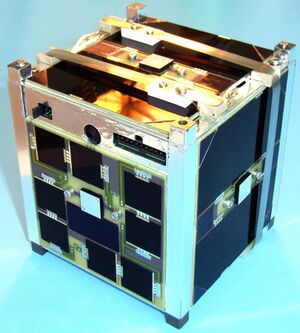Engineering:BeeSat-1
 BeeSat-1 before launch | |
| Mission type | Technology |
|---|---|
| Operator | TUB |
| COSPAR ID | 2009-051C |
| SATCAT no. | 35933 |
| Website | www |
| Mission duration | 12 months (planned) 15+ months (achieved) |
| Spacecraft properties | |
| Spacecraft type | 1U CubeSat |
| Launch mass | 1 kilogram (2.2 lb) |
| Start of mission | |
| Launch date | 23 September 2009, 06:21 UTC |
| Rocket | PSLV-CA C14 |
| Launch site | Satish Dhawan FLP |
| Contractor | ISRO |
| Orbital parameters | |
| Reference system | Geocentric |
| Regime | Sun-synchronous |
| Perigee altitude | 713 kilometres (443 mi) |
| Apogee altitude | 723 kilometres (449 mi) |
| Inclination | 98.36 degrees |
| Period | 99.01 minutes |
| Epoch | 21 January 2014, 05:49:02 UTC[1] |
BeeSat-1 or Berlin Experimental and Educational Satellite 1, is a German satellite operated by the Technical University of Berlin. The spacecraft is a single unit CubeSat, which was designed to test systems intended for use on future spacecraft, including a new design of reaction wheel.[2][3] It has also been used for amateur radio, and is equipped with a small camera.[4]
BeeSat-1 was launched by a Polar Satellite Launch Vehicle, serial number C14, flying in the Core Alone, or PSLV-CA, configuration.[5] The launch took place from the First Launch Pad at the Satish Dhawan Space Centre, at 06:21 UTC on 23 September 2009.[6] BeeSat-1 was a secondary payload aboard the rocket, which deployed the Oceansat-2 satellite. Five other secondary payloads were flown aboard the rocket; SwissCube-1, UWE-2, ITU-pSat1, Rubin 9.1 and Rubin 9.2.[7][8]
BeeSat-1 is operating in a Sun-synchronous orbit with an apogee of 723 kilometres (449 mi), a perigee of 714 kilometres (444 mi) and 98.4 degrees of inclination to the equator. It has an orbital period of 99.16 minutes.[9] BeeSat-1 was designed to operate for at least twelve months,[2] and (As of January 2011) it is still operational.[4]
See also
- 2009 in spaceflight
- List of CubeSats
References
- ↑ "BEESAT Satellite details 2009-051C NORAD 35933". N2YO. 21 January 2014. http://www.n2yo.com/satellite/?s=35933. Retrieved 21 January 2014.
- ↑ 2.0 2.1 "BEESAT-1". TUB. 25 May 2010. Archived from the original on 18 February 2011. https://web.archive.org/web/20110218222803/http://www.raumfahrttechnik.tu-berlin.de/beesat/v-menue2/beesat-1. Retrieved 6 January 2011.
- ↑ "BeeSat-1 (Berlin Experimental Educational Satellite-1)". eoPortal Directory. eoPortal. Archived from the original on 26 July 2011. https://web.archive.org/web/20110726032851/http://events.eoportal.org/get_announce.php?an_id=11635. Retrieved 6 January 2011.
- ↑ 4.0 4.1 "BEESAT". AMSAT. Archived from the original on 3 March 2011. https://web.archive.org/web/20110303221829/http://www.amsat.org/amsat-new/satellites/satInfo.php?satID=129. Retrieved 6 January 2011.
- ↑ Wade, Mark. "PSLV CA". Encyclopedia Astronautica. http://www.astronautix.com/lvs/pslvca.htm. Retrieved 6 January 2011.
- ↑ McDowell, Jonathan. "Launch Log". Jonathan's Space Page. http://www.planet4589.org/space/log/launchlog.txt. Retrieved 6 January 2011.
- ↑ Krebs, Gunter. "BeeSat". Gunter's Space Page. http://space.skyrocket.de/doc_sdat/beesat.htm. Retrieved 6 January 2011.
- ↑ Krebs, Gunter. "Rubin 9". Gunter's Space Page. http://space.skyrocket.de/doc_sdat/rubin-9-ais.htm. Retrieved 6 January 2011.
- ↑ McDowell, Jonathan. "Satellite Catalog". Jonathan's Space Page. http://www.planet4589.org/space/log/satcat.txt. Retrieved 6 January 2011.
 |

